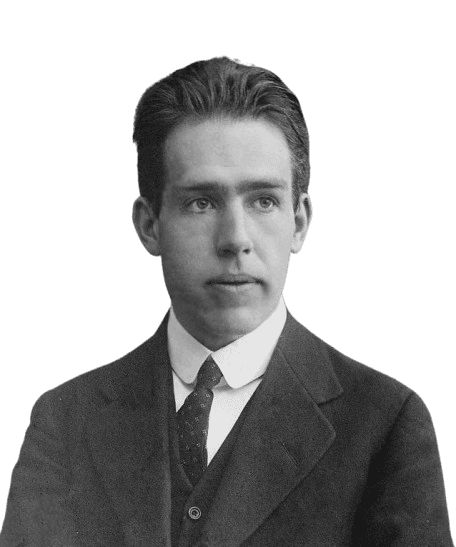Life and achievements
Early life
Niels Henrik David Bohr was born on 7 October 1885 in Copenhagen, Denmark, to a family of scholars. Christian Bohr, his father, was a professor of physiology at the University of Copenhagen, and his mother, Ellen Adler Bohr, was a Jewish woman from a wealthy banking family. His parents had one more daughter, Jenny, older than Bohr, and one son, Harald, younger than Bohr. He received his primary education at Gammelholm Latin School and was fond of science and mathematics from the beginning.
Bohr began his university education at the University of Copenhagen in 1903 and had Christian Christiansen, the only professor of physics at the university, as his teacher. He also took his astronomy and mathematics lessons from Professor Thorvald Thiele and his philosophy lessons from Professor Harald Høffding, who was a family friend. In 1905, Bohr received the gold medal from the Royal Danish Academy of Sciences and Letters for the work done on the surface tension of liquids, which proved his potential as a scientist.
Bohr's academic journey did not stop there; he went on to work on his doctoral thesis on the electron theory of metals, which he submitted in 1911. Although the paper was written in Danish, it was a work of great significance that paved the way for his subsequent works in atomic theory. Bohr continued his research in England, where he worked with J. J. Thomson and Ernest Rutherford. He worked with Rutherford at the University of Manchester, and together they came up with the Bohr model of the atom in the year 1913, which was a big step in the study of atomic structure.
Bohr married Margrethe Nørlund in 1912, and they had six children; two of them died in childhood. His family life was closely connected with his scientific activity, and Margrethe was an essential part of his life, helping him with translations and correspondence. Bohr's childhood and youth were characterized by scientific curiosity and individual determination, which paved the way for his achievements in science.
Legacy
It is not only for his scientific discovery that Niels Bohr is remembered; he left behind many other contributions. He contributed to the formation of quantum mechanics, and his model of the atom, known as the Bohr model, is still taught in physics classes. The principle of Bohr's complementarity has affected not only the field of physics but also the philosophy of science, particularly the duality of waves and particles and the inability of classical ideas to explain quantum mechanics.
Bohr was quite active during the Second World War; he aided Jewish scientists in their attempt to flee from the Nazis and was involved in the Manhattan Project, which led to the creation of nuclear weapons. He later became one of the most ardent supporters of the use of atomic energy for peaceful purposes and cooperation between nations in the sphere of science. He played a very active role in setting up the European Organization for Nuclear Research (CERN) as well as the Nordic Institute for Theoretical Physics.
The scientific community's recognition of Bohr can be seen in the various recognitions he received, such as the Nobel Prize, Order of the Elephant, and Atoms for Peace Award. He was a great teacher of many future Nobel prize winners and had a significant impact on the further development of physics. Today, the Niels Bohr Institute in Copenhagen is one of the major centres for theoretical physics research.
It is for this reason that Bohr's philosophical musings, mainly his focus on the insignificance of human understanding and the virtue of restraint in scientific exploration, remain relevant even today. His legacy has also been depicted in plays such as Michael Frayn's Copenhagen and many documentaries that illustrate his life and achievements. Niels Bohr is one of the most important scientific minds of the twentieth century, a man who was also interested in social justice and who reflected deeply on the nature of existence.
Milestone moments
Oct 19, 1913
Bohr's Model of the Atom is Published
October 1913 saw the publication of Niels Bohr's atomic model in the Philosophical Magazine.
This model brought in the idea that electrons revolve in circles around the nucleus and that the energy that these electrons can have is also at certain levels.
Bohr's model helped to explain the stability of atoms and the line spectrum of atomic emissions and thus changed the way nuclear structure was perceived.
His work paved the way for quantum mechanics, and he was greatly acknowledged in the scientific fraternity.
Nov 19, 1922
Nobel Prize in Physics
Niels Bohr received the Nobel Prize in Physics in November 1922 for his services to the advancement of physics in the field of atomic structure and radiation.
The Nobel Committee appreciated Bohr's contribution to the formulation of the Bohr model of the atom and the explanation of atomic spectra.
This made Bohr one of the most famous physicists in the world, and his research was known internationally.
His award pointed to the value of his work in the new and rapidly growing area of quantum mechanics.
Mar 19, 1921
Sep 19, 1943
Escape from Nazi-Occupied Denmark
Niels Bohr fled from Nazi-occupied Denmark in September 1943 because he was in danger of being arrested for being Jewish.
Bohr and his wife were spirited away to Sweden by the Danish resistance, and he moved to Britain later on.
In Britain, Bohr joined the Tube Alloys project and thus became involved in the allied work on nuclear fission.
This escape and his involvement in the Manhattan Project was one of the most significant periods in his life as it depicted his concern towards science and human welfare.
